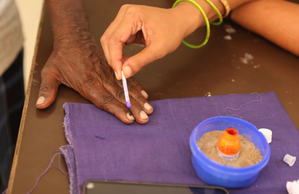New Delhi, May 28 (VOICElife) As a brand, there’s nothing more prestigious then becoming a part of India’s history, and Obeetee carpets managed this feat by bagging the Central Vista project in the Capital, which will feature its specially engineered carpets adorning the floors of Rajya Sabha and Lok Sabha along with the media and VIP galleries of these two prestigious buildings.
The 102-year-old company known for its premium hand woven carpets did extensive research on the themes – after a lot of brainstorming and drawing inspiration from our history – taking cues from the symbolic meaning behind these main central themes they came up with an exhaustive vocabulary of patterns to choose from. The construction was also specially designed to make sure that the design doesn’t get compromised. The entire process. from receiving the design brief to finalizing the pattern, to engineering the pattern with proper planning took 12 months. Post the ideation the carpets took about 8 months to weave.
All the carpets designed are handmade with two designs based on two central themes — the lotus, the national flower for the Rajya Sabha, and the national bird peacock, the theme for Lok Sabha.
The beauty of the design is that the carpets were planned and engineered to fit into a shape of a semi-circle. The pattern dissipates along with the play of color to create an ombre movement as the carpet moves out to the periphery.
VOICElife spoke to Rudra Chatterjee, Chairman, OBEETEE Carpets about can the brand experience and privilege of working on the project.
Obeetee
With this project Obeetee gets an opportunity to become part of India’s history, how did the brand bag the Central Vista project?
Rudra: Obeetee Carpets secured the Central Vista project through a combination of its legacy, expertise, and commitment to exceptional craftsmanship. The brand’s 102-year history as a premium manufacturer of handmade carpets, along with historically being a carpet manufacturer for the Rashtrapati Bhawan, played a significant role in gaining the opportunity. The brand’s dedication to preserving India’s rich cultural heritage through its craftsmanship and its alignment with the design vision for the project were also instrumental in bagging this prestigious opportunity.
What do you mean when you say “engineered carpets”?
Rudra: The term “engineered carpets” refers to the meticulous design and manufacturing process employed by Obeetee Carpets. These carpets are carefully crafted to meet specific requirements and challenges posed by the project. The carpets needed to fit into the shape of a semi-circle and harmonize with the architecture of the halls. This required the carpets to be engineered in separate pieces, which were then seamlessly joined together to create a unified carpet. The engineering aspect ensures that the carpets are precisely tailored to the space and create a visually appealing and cohesive effect.
What was the brief for the carpets at Rajya Sabha and Lok Sabha and share with us the idea behind the design and inspiration, along with the process of creating the motif?
Rudra: The brief for the carpets at the Rajya Sabha and Lok Sabha called for designs that exuded intricate artistry, vibrant colours, and subtle elegance. The idea behind the design was to pay homage to India’s rich cultural heritage and symbolism. The Rajya Sabha carpet draws inspiration from the national flower, the lotus, showcasing exquisite motifs of the lotus flower. On the other hand, the Lok Sabha carpet features enchanting peacock motifs, symbolizing India’s national bird. The carpets were meticulously crafted with 20-25 shades and adorned with intricate patterns, reflecting the brand’s commitment to unparalleled artistry.
The process of creating the motif involved extensive planning, design, and weaving. Skilled artisans and weavers at the brand’s factory headquarters in Mirzapur, Uttar Pradesh, meticulously wove the carpets with a high density of 120 knots per square inch. The motifs were carefully crafted to ensure their beauty and intricacy, resulting in stunning carpet designs that seamlessly integrated with the overall interior design of the halls.
How was the experience working with architects of the project and how long did they take to weave and are they hand tufted or woven?
Rudra: The experience of working with the architects of the Central Vista project was wonderful. Most of the design process and evolution of the final artwork happened during the pandemic through virtual meetings and zoom calls. The architects, along with the brand team, had a meticulous approach to design, aiming to ensure that the entire interior of the space worked in harmony with each other. The collaboration between the architects and our company resulted in a successful integration of the carpets into the overall design scheme.
The weaving process for the carpets took approximately 7 months to complete. The carpets were handknotted using 100% New Zealand wool by skilled weavers at our factory headquarters.
How did you finally lock in on the lotus and the peacock as the main themes?
Rudra: The selection of the lotus and peacock as the main themes for the carpets was a result of careful consideration and reverence for Indian symbolism and cultural heritage. The lotus holds great significance in Indian culture and is the national flower, representing purity, beauty, and spiritual awakening. The peacock, as the national bird, is admired for its grace, elegance, and vibrant display of feathers.
The choice of these motifs was a reflection of India’s rich cultural identity and the desire to incorporate these powerful symbols into the design of the halls. The lotus and peacock motifs were intricately woven into the carpets, capturing their essence and adding a touch of symbolic significance to the overall design.
As a made in India brand with a long standing and history do you feel the newer start-ups need to have a strong media presence to make an entry?
Rudra: As a brand with a long-standing history and legacy, our company has established itself as a trusted and renowned name in the industry. While a strong media presence can certainly benefit newer start-ups in terms of visibility and reach, the significance of our entry into the Parliament project goes beyond media presence alone. The company’s involvement in such a prestigious project underscores its craftsmanship, expertise, and commitment to preserving India’s cultural heritage.
The project serves as a testament to Obeetee’s legacy of excellence and its ability to deliver exceptional masterpieces. It reinforces the brand’s position as a provider of premium handmade carpets and its contribution to prominent heritage places and institutes. The project further solidifies Obeetee Carpets’ reputation as a brand that seamlessly integrates art and design in influential spaces, showcasing their commitment to creating remarkable pieces that stand the test of time.
(VOICElife can be contacted at ianslife@ians.in)


























































